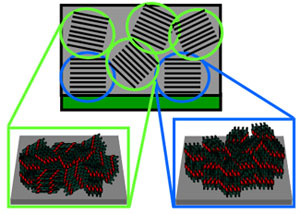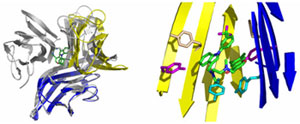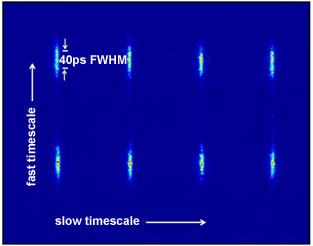

Contents of this Issue:
1. Science Highlight —
SSRL Aids Development of Plastic Electronics
(contact:
M.F. Toney, mftoney@slac.stanford.edu)

| |
| Schematic of orientation of crystals within the film. |
2. Science Highlight —
Developing Ways to Treat Arthritis
(contact: M. He, mhe@sunesis.com)
 | |
| Unusual inhibition mechanism of a small-molecule antagonist of the trimeric cytokine TNF-a. |
A team of scientists from Sunesis used macromolecular crystallography beam lines facilities at Stanford Synchrotron Radiation Laboratory to determine the structure of a potential TNF small-molecule inhibitor. X-ray diffraction studies showed that the small molecule had migrated into the center of TNF, where TNF's three subunits normally join. The small molecule then dislodged one of the three subunits, completely disrupting TNF. Turning a protein from a trimer (three parts) into a dimer (two parts) is an unusual, but clearly effective, method of inhibiting the action of a molecule.
This research enables pharmaceutical companies to identify properties of small
molecules in a systematic path towards the identification of the substances
that have the most potent inhibitory effects.
To learn more about this research see the full technical highlight at:
http://www-ssrl.slac.stanford.edu/research/highlights_archive/tnf-alpha.html
3.
SPEAR3 Accelerator Safety Envelope
(contact: R. Hettel, hettel@slac.stanford.edu)
It has been two years since photon beams were first delivered to users from the newly commissioned SPEAR3 light source. Routine SPEAR3 operation has been limited to 100-mA stored beam current at 3 GeV since that time by the DOE-issued Accelerator Safety Envelope (ASE) even though the machine was designed to operate at 500 mA. A milestone for SPEAR3 operation was reached recently when the DOE raised the ASE current limit to the design value.
The 100-mA ASE was formulated based on the outcome of the original Accelerator Readiness Review (ARR) that took place in 2003, a few months before SPEAR3 commissioning, when the full complement of radiation shielding and beam containment systems needed for higher current operation had not yet been designed and implemented. Since then, with the benefit of several special DOE-authorized accelerator physics test shifts at 500 mA, these components were developed and completed. In the fall of 2005 the "Phase II ARR" for high-current operation was held, which addressed operational and machine protection issues as well as the radiation safety systems, and the DOE confirmed that SSRL had successfully responded to the few findings from the review in early 2006. The only remaining impediment to raising the ASE to 500 mA was to make a final revision to the SPEAR3 Safety Analysis Document (SAD) to incorporate all the recent system modifications. This was accomplished by March and the final SAD was officially delivered to the DOE Site Office by the head of the SLAC ES&H Division, Sayed Rokni. On March 30, SLAC Director Jonathan Dorfan received a memorandum from Nancy Sanchez, the DOE Site Office Manager, raising the SPEAR3 ASE for beam current to 525 mA (to permit testing of interlocks designed to limit the operating current to 500 mA).
SSRL is planning to operate at 500 mA during special limited runs over the next year that will serve only the photon beam lines that have been fully converted for high-current operation. All beam lines presently undergoing upgrade will be ready for routine 500-mA operation following the summer 2007 shutdown.
4.
Streak Camera Measurements of the SPEAR3 Beam
(contact:
J. Corbett, corbett@slac.stanford.edu)
 |
 |
The Joint Center for Structural Genomics (JCSG, http://www.jcsg.org) held its 5th annual meeting on April 6-7, at The Scripps Research Institute (TSRI) in La Jolla, California. The JCSG is one of four large-scale structural genomics centers funded through the Protein Structure Initiative (PSI) of the National Institutes of General Medical Sciences (NIGMS).
This was the first annual meeting since the July 2005 start of the production phase of the PSI. A lot of exciting progress was reported. On the first day, the four core operational groups of the JCSG (Bioinformatics, Crystallomics, NMR and Structure Determination) each held sessions describing their core activities. The session for the SSRL-based Structure Determination Core highlighted the latest remote operation capabilities available at SSRL macromolecular crystallography beam lines through a real-time session, and the efforts that have been made to automate the structure determination process, as well as the streamlining of structure refinement. On the second day presentations focused on new technology and functional collaborations that are being pursued to strengthen the overall JCSG pipeline. A final session highlighted many of the interesting structures that have been solved by the JCSG and deposited in the Protein Data Bank, pointing to the need for follow-up studies to provide more detailed functional annotation for many of the proteins that are being studied.
Applications should include a brief academic record, a statement describing the
intended research area and how a knowledge of synchrotron radiation would
enhance those studies, a list of publications (if any), and information on how
to reach the applicant by email and phone through the period extending to the
time of the summer school. Applications are now being accepted. Early
decisions will be made beginning May 10 and final decisions by June 1.
Please submit new X-ray and VUV proposals by May 1; submit new Macromolecular
Crystallography proposals by July 1. Proposals received by these dates will be
reviewed in July and will be eligible for beam time beginning in November 2006.
If you are interested in help in preparing proposals, please let us know. We
are exploring user interest in a proposal writing workshop later this year.
For more information on the proposal submittal, review and scheduling process,
visit:
A number of positions are currently available at the LCLS, LUSI and SSRL.
Please refer to the Photon Science Job Openings page for more information about
these job opportunities.
__________________________________________________________________________
SSRL Headlines is published electronically monthly to inform SSRL users,
sponsors and other interested people about happenings at SSRL. SSRL is a
national synchrotron user facility operated by Stanford University for the
U.S. Department of Energy Office of Basic Energy
Sciences. Additional support for
the structural biology program is provided by
the DOE
Office of Biological and Environmental Research, the NIH
National Center for Research Resources and the NIH Institute for General Medical
Sciences. Additional information about
SSRL and its operation and schedules is available from the SSRL WWW
site.
__________________________________________________________________________
To leave the SSRL-HEADLINES distribution, send email as shown below:
To: LISTSERV@SSRL.SLAC.STANFORD.EDU
Subject: (blank, or anything you like)
The message body should read
SIGNOFF SSRL-HEADLINES
That's all it takes. (If we have an old email address for you that is
forwarded to your current address, the system may not recognize who
should be unsubscribed. In that case please write to
ssrl-headlines-request@ssrl.slac.stanford.edu and we'll try to figure out
who you are so that you can be unsubscribed.)
If a colleague would like to subscribe to the list, he or she should send
To: LISTSERV@SSRL.SLAC.STANFORD.EDU and use the message body
SUBSCRIBE SSRL-HEADLINES
6. User Advocacy Update
(contacts: J. Andrews, andrews@csueastbay.edu;
C. Kim, cskim@chapman.edu;
L. Downward, lmd@physics.ucsc.edu)
NUFO: User representatives and administrators from user facilities are
part of a group called NUFO (National User Facility Organization) which meets
periodically to discuss issues of common interest, to share best practices, and
to brainstorm opportunities for closer interactions http://www.bnl.gov/nufo/.
Sacha Kopp (University of Texas at Austin), Chair of the Fermilab Users'
Executive Committee, organized the last meeting held in Illinois at the end of
March. This very constructive meeting included discussions about user advocacy
as well as safety and security at user facilities (see http://www.hep.utexas.edu/~kopp/nufo/transparencies/). The meeting
featured an
impressive panel of speakers who gave tips on communicating the need for basic
sciences and user facilities to a broader audience as well as a summary of the
President's American Competitiveness Initiative. NUFO representatives are
exploring the possibility of a combined trip for synchrotron, neutron and high
energy physics users to visit Washington, DC in October to further communicate
the importance of basic science and scientific user facilities. In preparation
for these types of activities, SLAC Users' Organization Chair Abner Soffer is
arranging a brief workshop to encourage and enable users to communicate the
excitement and importance of their research to a non-scientific audience
(session tentatively scheduled for May 26 in the SLAC auditorium). The next
NUFO meeting is tentatively scheduled for April 2007 in Berkeley.

SSRLUOEC: In addition to the above issues of user advocacy, several
other
issues were discussed at the April 17 meeting of the SSRL Users' Organization
Executive Committee (SSRLUOEC). Topics included planning for SSRL's Annual
Users' Meeting and Workshops (October 11-13, 2006), discussion of two versus
three fills per day (currently shutters are closed for 2-5 minutes three times
daily for SPEAR3 injection), future developments related to new imaging
capabilities and continuous scans, preparations for 500 mA operations, and
plans for timing mode studies. The SSRLUOEC represents the entire SSRL user
community, and we would appreciate user feedback on these or any other issues
of interest to users. The SSRLUOEC would also appreciate input from users on
whether they would be interested in a proposal writing workshop to be held in
conjunction with the October 12-13 Users' Meeting; if yes, what elements would
you like to see included in such a workshop? Contact information for your user
representatives is posted via the web:
http://www-ssrl.slac.stanford.edu/users/ssrluo/ssrluoec-fy06.html
http://www-ssrl.slac.stanford.edu/users/ssrluo/ssrluoec-mtgs.html
7.
Apply for Berkeley-Stanford Summer School

(contacts: D. Attwood, attwood@berkeley.edu;
A. Nilsson, nilsson@ssrl.slac.stanford.edu)
The fifth Berkeley-Stanford summer school will provide basic lectures on the
synchrotron radiation process, requisite technologies, and a broad range of
scientific applications. Visits to SSRL and the ALS will be included, with
opportunities to interact with the professional staff and graduate students at
both facilities. The summer school will be limited to approximately forty
graduate students, with a preference for those pursuing doctoral research in
the physical sciences in which synchrotron radiation is expected to play a
significant role. The summer school is jointly sponsored by UC Berkeley;
Stanford University; LBNL; and SSRL. Lectures will be presented by professors
and scientists from these four organizations and their user communities. The
summer school will be housed on the UC Berkeley campus. Co-chairs of the
summer school are David Attwood (attwood@berkeley.edu) and Anders Nilsson
(nilsson@ssrl.slac.stanford.edu). Details describing the summer school,
planned lectures, housing, costs and how to apply are posted at
http://www.unex.berkeley.edu/eng/synchrotron
8. User Administration Update
(contacts:
C. Knotts, knotts@slac.stanford.edu;
L. Dunn, lisa@slac.stanford.edu)
http://www-ssrl.slac.stanford.edu/users/user_admin/guide.html
9.
Photon Science Job Opportunities
http://www-ssrl.slac.stanford.edu/photonscience/jobs.html
SSRL Welcome
Page | Research
Highlights | Beam Lines | Accel
Physics
User
Admin | News & Events |
Safety Office